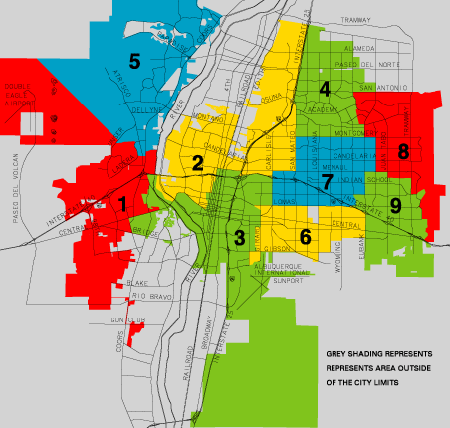
In this activity students will learn why the City of Albuquerque and Bernalillo County are divided into governing districts. They will learn what districts their homes and schools belong too, and what city counselor and county commissioner represent them in local government. They will explore the history of why the two governments chose a districting system and why their particular districts were created the way they were. Students will explore whether or not current districting allows for fair and democratic representation of their districts' population. They will look at census data, as well as conduct interviews with their city and county representatives to determine the demographics (ethnic, income, lifestyle, etc.) of the people living and working within those districts. Based on their findings, students will redistrict the city and county (drawing new boundaries on a classroom map) and defend their reasons for drawing these new boundaries (or maintaining old ones, or doing away with the whole thing in general). Students will have to work with those researching and representing neighboring districts to come to a consensus about how the whole county and city will be divided up (or not) in the end.
Objectives
Students will learn:
At least two class periods and out-of-class research time
High School
Vocabulary Used
Paper and pens, Census Data Reports, Maps of the Albuquerque Area
1. Setting the scene
Explain to the students that the City of Albuquerque and Bernalillo County are divided into City and County Districts. City Districts have different boundaries than County Districts. Each of the 9 City Districts has a different city councilor that represents it. Each city councilor is elected by the voters of that district and represents that district's population and needs in city decision making. Likewise, each county district is represented by one of the five county commissioners elected by that county district's voters, and responsible for representing that district in county decision-making.
These councilors and commissioners are the citizens' most important and direct representatives in local government. They are responsible for making sure that people in their districts are fairly represented in government undertakings. By analogy, they make up the legislative body (like Federal Representatives of the House and Senators) that create the laws and manage the affairs of local government, and maintain the checks and balances on the Executive Branch of the Mayor and County Manager (who are like the National President).
2. Identifying Current City and County Districts and their History
Ask students to look at the maps found in the Supplementary Information Section of this activity to identify which City and County districts their homes and schools fall within. Ask students to identify which City Councilors and County Commissioners represent those districts. Have students look at the districts that border their own and then the city and county as a whole, and discuss why they think these district boundaries may have been chosen. Have them think about how population numbers, ethnic diversity, and income may have been considerations in these boundaries.
3. Demographics and Representation of Districts
Divide students into groups, so that each group has one city district to investigate. Have students identify what county districts overlap with their city district. Have students research the history and current demographics of the neighborhoods that fall within their districts. Have them determine what ethnic and economic groups/stakeholders have historically been located in their districts, why the Charter in 1974 may have decided the specific boundaries for their district to be what they are, and what current population trends and characteristics are present currently in their districts. In this information gathering phase of the project students will want to look at historical information about their neighborhoods in the Albuquerque Environmental Story, demographic data from the city, the 2000 Census Bureau, the Rusk Report, and interview their city councilors and county commissioners directly.
4. How would you redistrict the county and city?
After students have gathered information about their districts, ask students to think about following questions:
5. Defending and Creating New City and County Governing Bodies for these Districts
Each student group representing a city district will make a discussion within their group about how they would choose their district's boundaries (they might even decide to break their district into several new districts or dissolve it all together) according to what they have learned and discussed in the previous steps of the activity. Each group will elect a representative who will act as their city councilor, someone that will represent their new district to the best of her/his ability. Each of the nine city councilors will meet in front of the class and draw their group's new district boundaries on a map of the Albuquerque Area in a different color and defend to the class why their group has decided on these particular boundaries. Once all groups have drawn their boundaries and defended them, students will identify areas of overlap. The council must now debate to find a way to make all these districts somehow “equal,” “fair,” and “democratic” in their representation. Students may find that they cannot come to a consensus about boundaries and population representation. When students have either come to a consensus or gridlock concerning districting and the issues, it is time to end the debate. Conclude the activity with an open discussion by students about what they have learned about democratic representation in local government. Ask students if they understand local government structure better and if they feel more empowered now to have their individual voices heard in local government decision making.
Information about the History of Albuquerque and Bernalillo County Districting
• Shared Vision CYE Website
More Information about Albuquerque Demographics
• Very Useful Maps and Census Data can be found in the Appendix (Very End) of the Rusk Report and Unification Exploratory Group Report at: http://www.cabq.gov/council/UEG%20Report.pdf
• Albuquerque Demographics and Statistics: from the City of Albuquerque at http://www.cabq.gov/planning/statistics/index.html#index
• 2000 Census http://www.cabq.gov/planning/statistics/census2000.html
History of Albuquerque Neighborhoods and Areas
• Albuquerque Environmental Story: has information about the history of each neighborhood and its human and natural characteristics in detail in Part 3: Sense of Place at: http://www.cabq.gov/aes/s2index.html
• Many Albuquerque Neighborhood Associations have information about their area's history on their websites…..Neighborhood Associations:
Information about Current City and County Districts and their Representatives taken from the City and County Websites :
• City of Albuquerque Districts and City Council Members

To contact the City Council write or call:
Albuquerque / Bernalillo County
Government Center
One Civic Plaza NW
City Council, Room 9087
Albuquerque, NM 87102
Telephone: (505) 768-3100
Office Fax: (505) 768-3227
e-mail all counselors at citycouncil@cabq.gov
To see more about individual counselors visit:
http://www.cabq.gov/council/ccmeet.html
To learn about City Council meetings visit:
http://www.cabq.gov/council/cc_sched.html
• Bernalillo County Districting and Commissioners
To contact the county commission call or write:
Bernalillo County Commission
One Civic Plaza N.W.
Albuquerque , N.M. 87102
Phone: 768-4000
The following maps show county district boundaries:
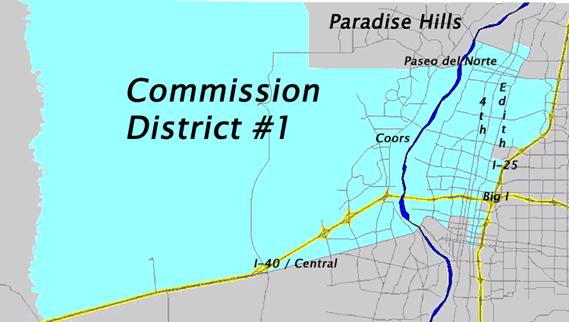
|
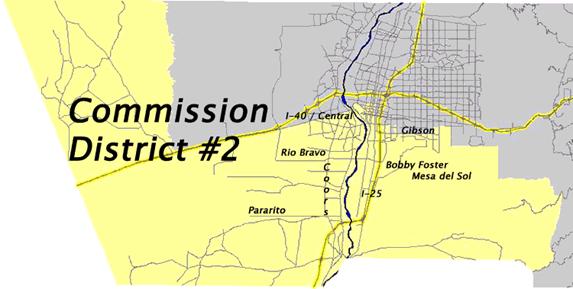
|
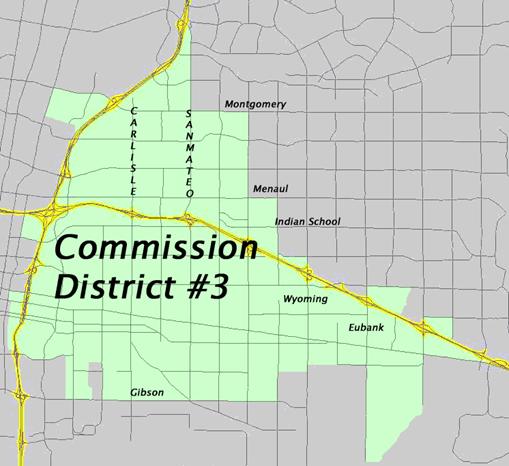
|

|
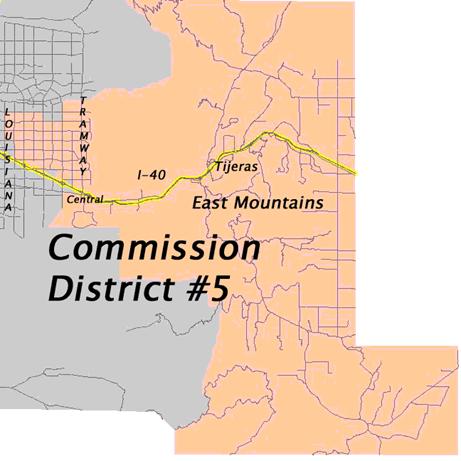
Activity Written by Melanie Stansbury for Shared Vision, 2003